Florida Manatee is Florida’s state marine mammal. These species live in Florida waterways and come close to shore, making them a target for powerboats, fishing gear, and speedboats that increase manatee deaths and manatee carcasses sightings. They are also threatened by natural disasters such as hurricanes and coastal development.
- Status: Endangered
- Known as: Florida Manatee, West Indian manatee.
- Estimated numbers left in the wild: Approximately 5,000, but estimates vary.
Florida Manatees are often found on the endangered species list due to these threats but some conservationists believe that these manatee species’ numbers have been increasing over recent years.
Let’s dig deeper into Florida manatees!
Description
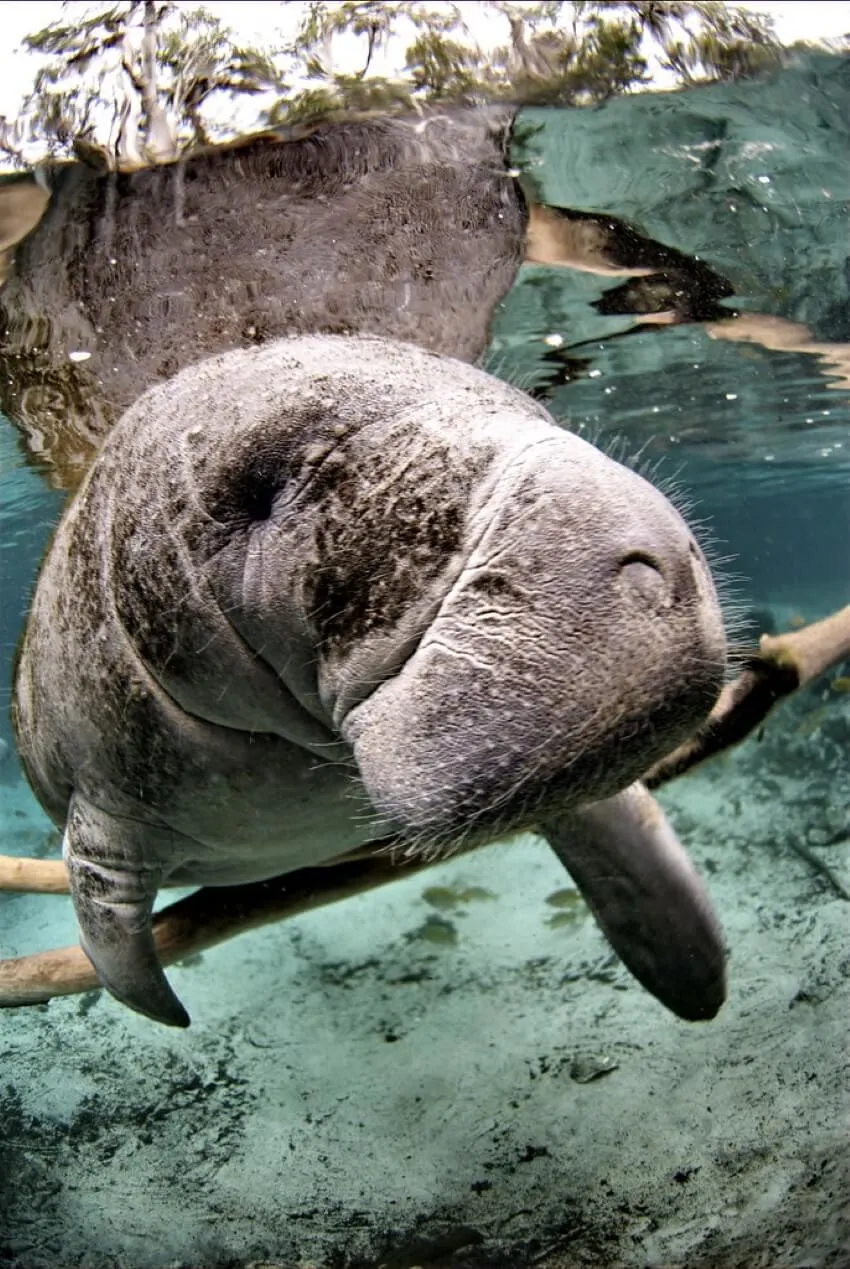
Florida manatees are large, herbivorous mammals. These big mammal species can be found in Florida’s waterways. These species are often mistaken for mermaids because of their human-like flippers and long, plantigrade tails that resemble a mermaids’ hair.
The Florida species of manatee’s head is rounded and its nostrils are located at the tip. Because of the number of Floridians who frequent manatees, the state flag, quarter, and plates are all adorned with them. The average length of these species are 10 feet and it weighs approximately 8000 to 1,000 pounds.
Anatomy and Appearance
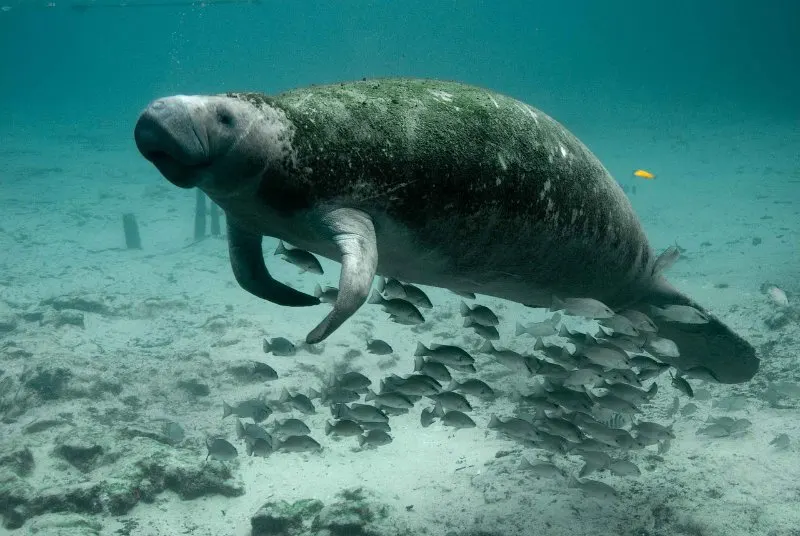
The Florida manatee, an endangered subspecies of the West Indian manatee, found mostly in Northeastern South America is a vaguely seal-like marine mammal measuring 3 to 3.6 meters long on average and weighing 680 to 820 kilograms.
Manatees are ocean-dwelling herbivorous mammals closely related to elephants, though the two groups split as long ago as 60 million years.
Grey-brown and largely hairless, The Manatee Florida native species have forelegs adapted into flippers and a muscular, flattened tail that provides a strong swimming stroke.
These manatees have no teeth except molars, which fall out and regrow as they are worn down by chewing the water plants that form their diet.
Historical range
Throughout the past century, the manatee has lived on the American coasts and Gulf Coasts, throughout the Caribbean, as far south as the Brazilian coast.
But because of hunting and habitat fragmentation, the manatee population has been eliminated. For instance, manatee hunts have been common throughout the 1800s which has not yet been seen in Guadeloupe or in other island countries.
Location
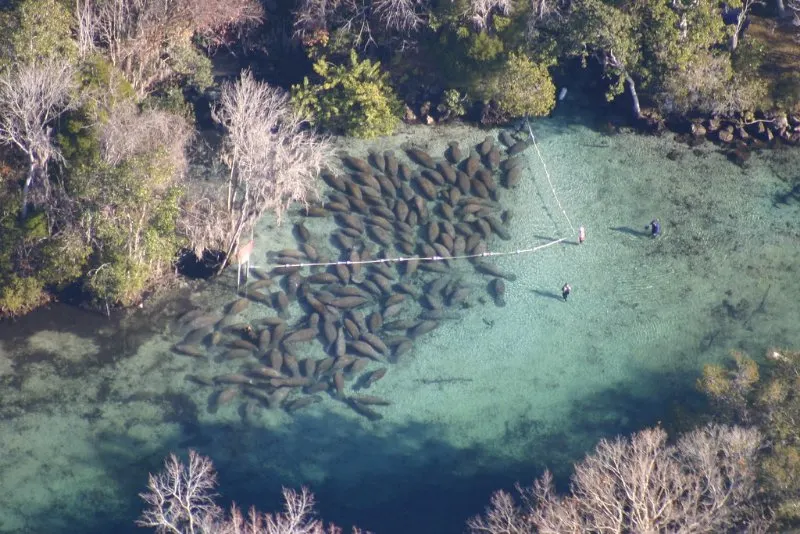
These species are found in the warm coastal waters off the south-eastern and southern United States, ranging as far north as Georgia. They formerly migrated south but now remain near power plant outflow areas.
The big mammal species have a space to escape the threats they face in Florida’s waterways and Florida’s marine environment.
Florida is not only home to these manatee species but many other threatened species such as Red wolves, Northern right whales, Kemp’s Ridley sea turtles, Loggerhead sea turtles, Eastern diamondback rattlesnakes, Florida panthers, and Florida black bears.
Florida Manatee Habitat
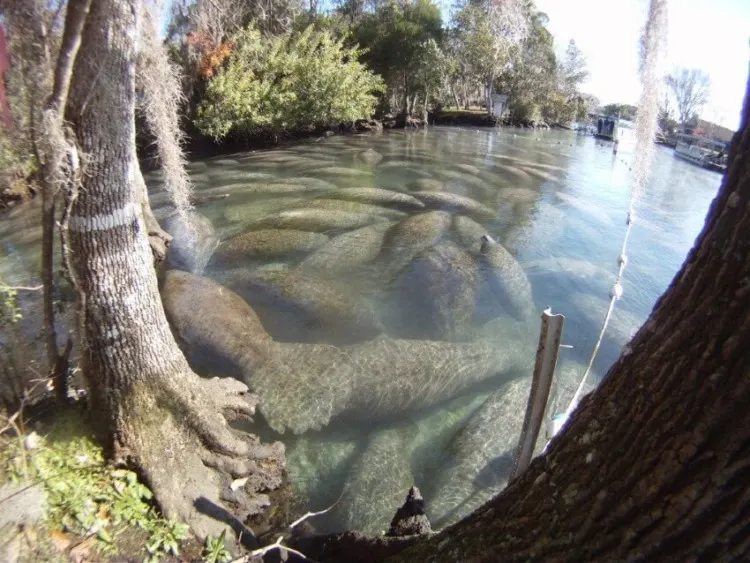
These endemic manatees live in Florida’s waterways and come close to shore, making them a target for powerboats, fishing gear, and speedboats.
They are also threatened by natural disasters such as hurricanes and coastal development. They prefer living in a warm water habitat.
These manatees stay in shallow coastal waters and appear to need exposure to both fresh and saltwater to survive. Like all other manatees, these species of manatees need to stay in water that is 20 degrees C or warmer all the time.
The thermal shock from entering cooler water can quickly kill a manatee, and long-term survival would be impossible even in cases where immediate death did not occur.
This limits the maximum northward range of the species and confines them to subtropical and tropical waters. These manatees originally migrated south in the winter, but now many remain in the warm discharge waters of power plants, which may raise their vulnerability even higher.
Florida Manatee Diet and Nutrition
These species are herbivorous and they also often eat plant material, such as seagrass and mangrove leaves. These species feeds primarily by grazing on the tips of the vegetation that is around them, stirring up sediment with their large flippers.
These endemic manatee species in Florida can subsist on a diet of almost exclusively seagrass, subsisting only every two weeks or so on other types of food. They do not eat while at sea and these manatees do not drink water while at sea due to the manatee having a saltwater stomach and intestines.
They still need to take in water for survival though, but these manatee species absorb water through their skin.
Suitable Florida habitats for these manatees are Florida waters in general plus the Florida Bay, the Caribbean Sea, and the Gulf of Mexico.
These endemic manatee species in Florida can be found along the coasts of Florida all around, though Florida is the only state where these species are located.
They eat water plants that grow in both environments, and though they tend to be slow-moving, they can muster the energy to be playful at times, too. They eat as much as 15% of their body weight in underwater foliage daily.
Florida Manatee Mating Habits
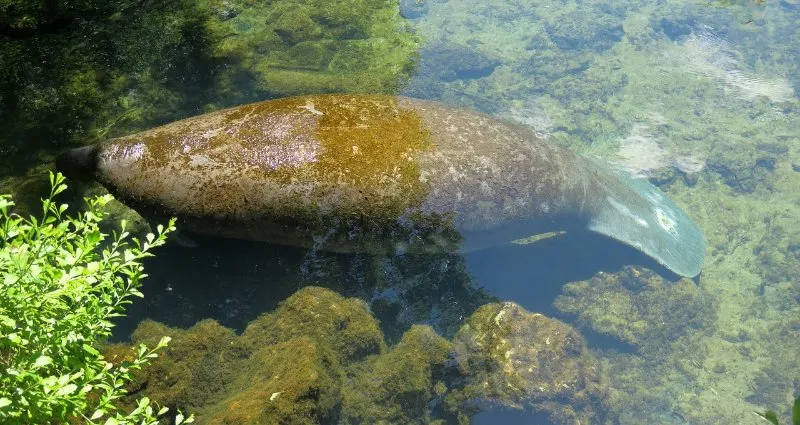
Florida Manatees are polygamous and will mate with more than one partner during the mating season. The mating season is typically in the winter months from November to March.
Manatees are slow-breeding creatures, their gestation period is about 12 months, and the manatee gives birth to one calf at a time. These endemic manatee species in Florida nurses their calves for about two years. They may live up to half a century in the wild.
Female Florida Manatees give birth to one calf after a 12 month gestation period. The calves are about three feet long and weigh around 65 pounds at birth.
Female manatees are typically larger than male manatees, and they have a rounder abdomen. Male manatees have a broader chest and a flatter abdomen.
The Manatee calves are generally born with lots of hair, but it falls out within a few weeks. Their calves are usually about three feet long when they are born.
Florida Manatees can be born year-round, but most of these manatee native species’ births occur during the summer months.
Calves nurse for nine to twelve months and the females give birth to manatees every two to five years.
These manatee species juveniles remain with manatee mothers until they are about 18 months old when their calves begin to eat vegetation.
They can reach sexual maturity when they are four or five years old and have a lifespan of about 40 years.
Natural Predators
Florida Manatee’s natural predators include sharks, alligators, and panthers. These manatee species are also hunted and killed by human causes for every Florida manatee that dies of natural causes. Their main predators are alligators, sharks, and humans.
These species live in Florida’s waterways and come close to shore, making them a target for powerboats and fishing gear. These manatee species are also threatened by natural disasters such as hurricanes and coastal development.
They are often found on the endangered species list due to these threats, but some conservationists believe that these endemic in Florida manatee numbers have been increasing over recent years. We need to prevent the manatees from becoming extinct!
Role in the ecosystems
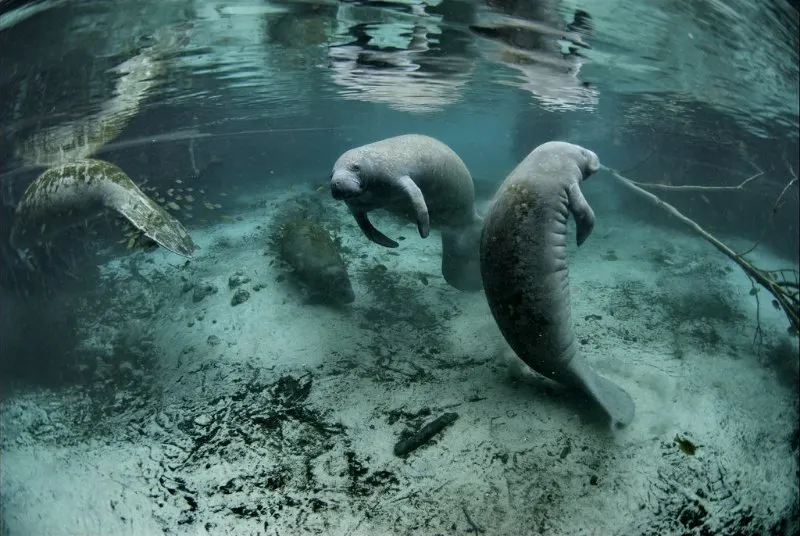
The Florida manatee has an important function in Florida’s ecosystems. It is a host to various pathogens (such as bacteria) that perform important services for Florida’s wildlife and Florida’s ecosystems.
They are an important part of the Florida ecosystem. They are herbivores and help to keep the waterways clean by eating aquatic plants. These manatee species are also prey species for many predators, so they play an important role in the food web.
These species are foundational species in Florida’s waterways, and Florida’s landscape is greatly shaped by the endemic in Florida manatee activity.
Presence is also key for Florida’s economy to thrive; tourism based on manatee sightings has contributed over 22 billion dollars to Florida’s economy each year.
These species play a key role in Florida’s economy. they are an important part of Florida’s ecosystems, and Florida Manatee tourism brings in $22 billion to Florida’s economy each year.
Group Structure and Behavior
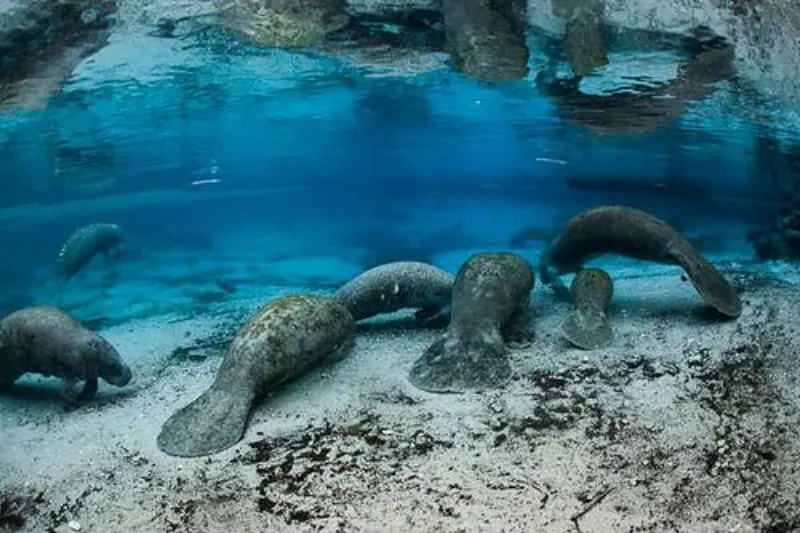
Florida Manatees are a social species that live in groups of 10-20. Their groups are usually all females, except for when a male joins the group for a short time during the mating season. They communicate with each other by vocalizing and by touching.
These endemic in Florida manatee used to warm waters and can be found in temperatures up to seventy degrees Fahrenheit.
However, when the water temperature drops below sixty-five degrees Fahrenheit, they will move to a warmer area. These species are also affected by salinity levels in the water. If the salinity level is too high or low, Florida Manatee will move to a different area.
Florida Manatee is a herbivorous marine mammal that can weigh up to 1,300 pounds. the endemic in Florida manatee species often eats seagrass, but can also consume some algae and other aquatic plants.
They are very gentle creatures and will often flee from danger rather than fight. These species are slow-moving and spend a lot of time grazing in the water. Florida Manatee is mostly active during the day and sleeps at night.
The manatee can live up to 60 years, but these manatees living in captivity have been recorded to have an average aquatic lifespan of 45 years.
Florida Manatees are very loving creatures and will often form strong bonds with other Florida Manatees.
There are several Florida Manatee populations, but most of their sightings occur in the winter months. These native species are migratory species, and many Florida Manatees will move to the Crystal River area to warmer waters.
Some Florida Manatees will also travel to the Tampa Bay area. Florida Manatee populations have been increasing in recent years, but they are still vulnerable to threats and are often found on the endangered species list.
Florida Manatee and Human Relationship
Since Florida Manatee is commonly found in Florida’s waterways, it has a close relationship with humans. Florida Manatee is often sought out by tourists and locals alike who want to catch a glimpse of this gentle giant.
However, this closeness has also led to Florida Manatee being threatened by various human activities. For example, these manatees are often struck by boats and killed due to negligent boaters.
Additionally, they are susceptible to fishing gear and can be hurt or killed if caught in a net or trap.
Florida Manatee vs Other Manatee Species
There are three manatee species found in the world, and Florida Manatee is the only one found in North America. The other two manatee species are the West Indian Manatee and the Amazonian Manatee.
Florida Manatees are distinguishable from these other two species because they have a flattened tail, Florida Manatees are also generally larger than the other two species.
Florida Manatee is also the only manatee species that live in freshwater, while the West Indian and Amazonian Manatee lives in saltwater environments. Florida Manatee is often found in Florida’s waters, which include the Atlantic Ocean and the Gulf of Mexico.
Florida Manatees are also commonly sighted around Florida’s coasts, Florida’s rivers that contain freshwater, Florida’s springs systems with freshwater, Florida’s power plant discharge canals (warm water habitats), and Florida’s agricultural drains with fresh water.
The endemic manatees are often mistaken for being “humpbacks” when in the ocean, but these species get their name from the fact that they resemble Florida’s dugong which is called Florida Sea Cow.
Florida and West Indian manatees live in Florida’s waterways and come close to shore, making them a target for powerboats, fishing gear, and speedboats. They are most commonly found in Florida while West Indian Manatees are most commonly found in the waters surrounding Florida.
These manatees are often found on the endangered species list due to these threats, but some conservationists believe that manatee numbers have been increasing over recent years.
Florida Manatee is often referred to interchangeably with Amazonian Manatee. The Florida manatee can grow up to 10 feet long while an Amazonian manatee can grow up to 16 feet long.
Florida Manatees are more solitary than Amazonian Manatees; Florida Manatees live alone or in small groups while Amazonian Manatees live in large groups. Florida Manatee is a subspecies of the West Indian manatee and Florida Manatee can be found in Florida’s waterways from spring to fall.
Florida Manatee Facts
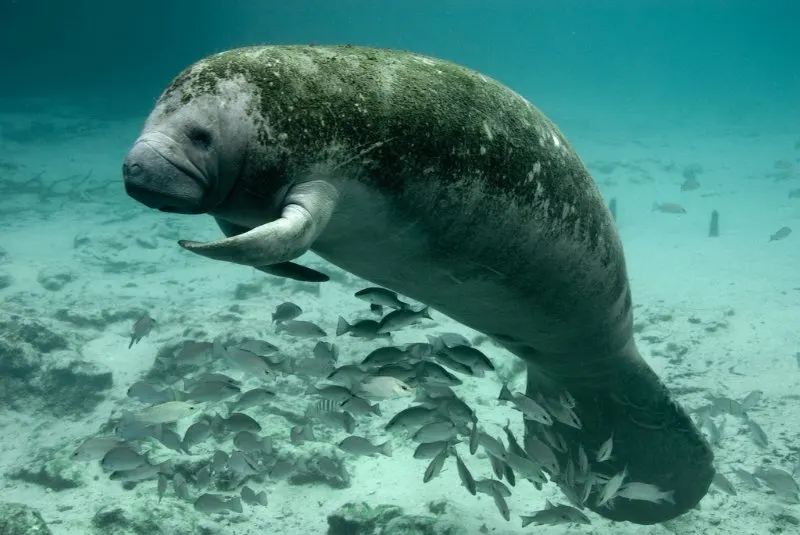
Here are the fascinating facts about the Florida manatee that you need to know.
- These manatee endemic species in Florida are the only type of mammal that can stay underwater for up to 20 minutes
- They have flippers, but no tail (dolphins and whales do).
- Mostly live in a warm water habitat
- These species’ babies are born so small they weigh less than a pound!.
- They are known as “sea cows” because they eat seagrass
- Their numbers have been increasing over recent years
- They are the official state marine mammal of Florida.
- The manatee endemic species in Florida can weigh up to 1,300 pounds and grow up to 10 feet long.
- They are herbivores, eating mainly aquatic plants.
- These species can live up to 60 years old.
- The manatees prefer water temperatures of 68-72 degrees Fahrenheit.
- This manatee species is often found in Florida’s waterways, Florida Bay, estuaries, rivers, coastal areas, reservoirs, canals, and springs.
- These species are known for its slow-moving behavior.
- They are docile, gentle animals that are slow on the water but capable of speed when on land.
- They are often referred to as “sea cows” because these manatees eat, sleep, and even give birth in the water.
- This manatee species is also known for its long periods of Florida Manatee activity during winter months when manatees can be found Florida Manatee at springs or near power plants.
See Related: Olive Ridley Sea Turtle
Conservation Status
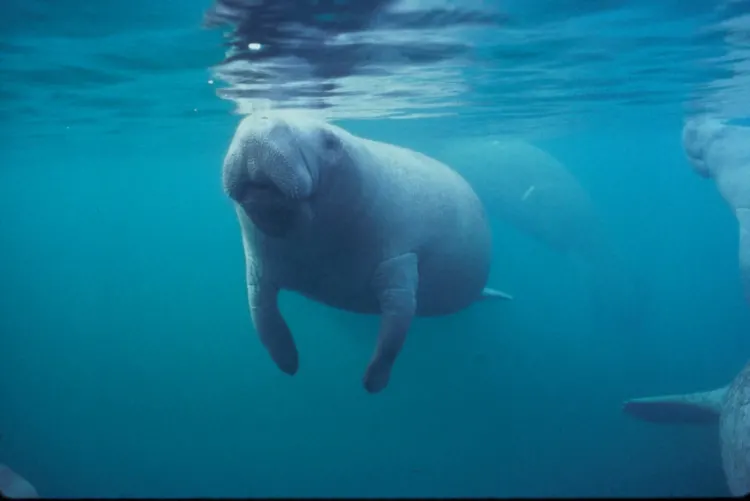
These species are now on the endangered species list due to Florida’s waterways. They are often seen as a threat to Florida’s economy and conservationists believe that manatee numbers have been increasing over recent years.
These species are often found on Florida’s coastline and Florida’s waterways. they are often seen close to shore by powerboats, fishing gear, and speedboats.
The population of Florida Manatee has been decreasing because of natural disasters such as hurricanes and coastal development. Some conservationists believe that manatee numbers have increased in recent years due to Florida’s conservation efforts.
Threats
Collisions chiefly threaten Florida manatees with boats – few lack scars from propellers hacking through their flesh, and some are hideously maimed yet manage to survive.
Many more die outright from being chopped to pieces or perish from infections later. Though the image of the reckless and selfish speedboat owner chopping callously through manatees is a powerful one, these boats are responsible for very few of the injuries due to the propellers’ construction.
It actually tugs boats and large boats that injure and kill manatees that increasing the number of manatee mortalities.
The low sound of their engines is inaudible to manatees, and the animals, therefore, do not know to get out of the way since they cannot detect the boat until it strikes them. Red tide and ingested fishing gear are other hazards.
Fortunately, these manatees are not quite as scarce as once believed since a 2010 count provided a hard figure of at least 5,000 individuals instead of previous unsupported estimates of 2,000 or less.
However, the subspecies’ survival is still fragile, and strong conservation efforts are needed to preserve these gentle, intriguing sea creatures from extinction.
They were hunted in Florida in the 1950s for their meat and blubber, which was used for oil substitutes. In 1967 the Florida state legislature outlawed the hunting of manatees. This did not stop fishing trawlers which kill many Florida Manatees with their nets for shrimp every year.
These continuous manatee collisions with boats and damages to seagrass beds by manatees are a major concern, manatees are also threatened by toxins in the ocean.
Florida State has passed several laws to protect manatees and many areas have been designated as manatee protection zones.
See Related: Endangered Species in California
Conservation efforts
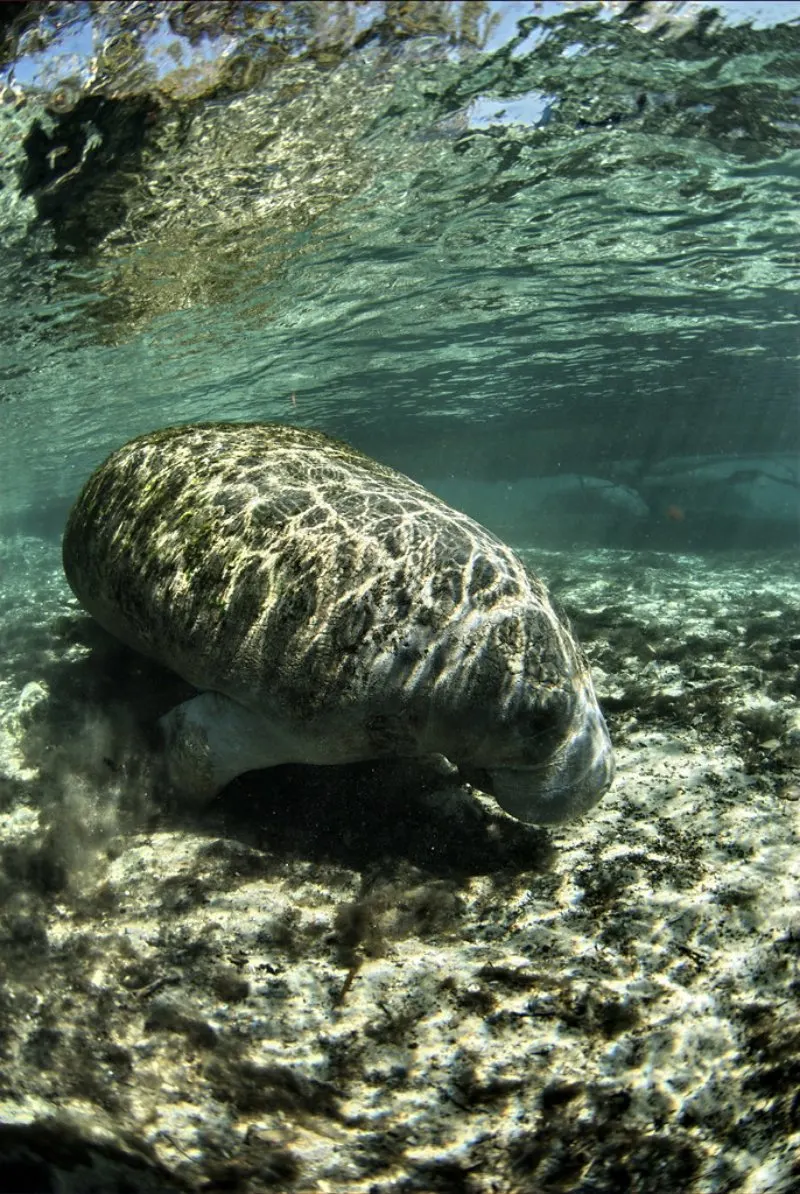
The manatee was one of the earliest animals to receive legal protection in the United States, reaching back as far as the late 19th century.
Sea World of Florida has played a key role in helping conserve manatees with its rehabilitation efforts. In contrast, the U.S. Fish and Wildlife Service has engaged various programs to aid in manatee protection, and many local efforts are underway also.
Endangered Species Act
The Endangered Species Act of 1973 is a law that regulates what types of animals can’t be hunted or disturbed without a permit from the U.S Fish and Wildlife Service.
Florida has its own versions of the law, with some different restrictions for hunting Florida Manatees.
In Florida, Florida Manatees are a protected species. Florida has a permit process for hunting Florida Manatee, but these species aren’t considered “game animals.” They can be hunted as long as they have been legally taken from Florida waters and have been killed legally. This endemic manatee is also threatened by the destruction of Florida’s natural Florida wetland, warm water habitat, and coastal development.
Marine Mammals Protection Act
One law passed by the Florida legislature was called the Marine Mammal Protection Act. The Marine Mammal Protection Act was enacted because Florida has a shared interest with other coastal states and countries in ensuring the conservation of Florida’s manatee population.
This Act includes provisions concerning Florida’s manatees and other marine mammals. Florida is also known for its manatee population and the manatee is often found on the endangered species list.
Florida state law
Florida is one of the states with the highest risk to manatee due to its coastline location. Florida has enacted laws in order to protect these manatees. Florida Manatee Conservation Act was adopted by Florida as a way of protecting these manatee species as well as educating people about these species.
This act deals with powerboats, fishing gear, and speedboats as well as mangroves and salt marshes that are closed to hunting and trapping. This conservation act also bans people from attaching anything to these species or hurting them in any way.
Others
There are a plethora of conservation efforts to help conservation and save the manatees from extinction. Here are some of the conservation efforts:
- In Florida, there are many community outreach programs with partners such as Florida Fish and Wildlife Conservation Commission and Kids Enjoying Nature that offer opportunities for citizens to help Florida Manatee by volunteering their time or donating funds
- Many people have been working on new technology that is meant to reduce watercraft collisions with manatees in areas where they often reside, which includes coastal waters near power plants, wastewater treatment facilities in Boca Raton, and Melbourne Beach outlets.
- Preventing people from feeding wild animals is another way we can make sure these big mammals don’t become entangled in fishing gear and other hazards
- Florida has also been working on restoring mangrove habitat to give these Manatees a place to thrive, which involves increasing the amount of hardwood hammock and seagrass beds that these manatees can feed on.
- Florida’s power plants contribute less than 1% of Florida’s overall greenhouse gas emissions, making Florida not such a big culprit in climate change.
- These manatees are endangered because of the common dangers they face when close to shore and with boaters who do not always follow speed restrictions.
See Related: Why Should We Care About Climate Change?
Organizations
Save the Manatee Club
Save the Manatee Club focuses its efforts on protecting the three species of manatees and their marine habitats through advocacy, public awareness, education, research, rescue, and rehabilitation.
The club’s mission is to protect manatees like Florida manatees and their warm water habitat. The club does this by working with Florida’s government, businesses, and citizens to promote conservation measures for Florida manatees.
Some of the measures that the club has promoted include boat speed restrictions in manatee habitats, manatee sanctuaries, and legislation to protect these species.
Florida Fish and Wildlife Conservation Commission
The Florida Fish and Wildlife Conservation Commission is a government agency responsible for the management of Florida’s fish and wildlife. The agency was established in 1999 as a result of the merger of Florida’s Game and Fresh Water Fish Commission and Florida’s Marine Fisheries Commission.
The commission is responsible for the management of Florida’s fish and wildlife, which includes: – Protecting Florida’s fish and wildlife – Regulating fishing and hunting in Florida – Preserving Florida’s natural resources – Educating the public about Florida’s fish and wildlife.
One of the commission’s main responsibilities is to protect Florida’s fish and wildlife, which includes Florida Manatees. Unfortunately, these species are threatened by a variety of threats.
World Wildlife Fund
The World Wildlife Fund (WWF) is an international non-governmental organization that focuses on the conservation, research, and education of threatened species They are one of the many species that the WWF focuses on.
The fund has been able to help Florida Manatee populations rebound in recent years by providing conservation efforts, such as:
- Providing resources to better understand these species populations and habitats
- Working with local governments to create and enforce legislation to protect these species
- Collaborating with researchers to study Florida Manatee migration patterns and causes of death
- Educating the public about the endemic manatee conservation
Final Thoughts
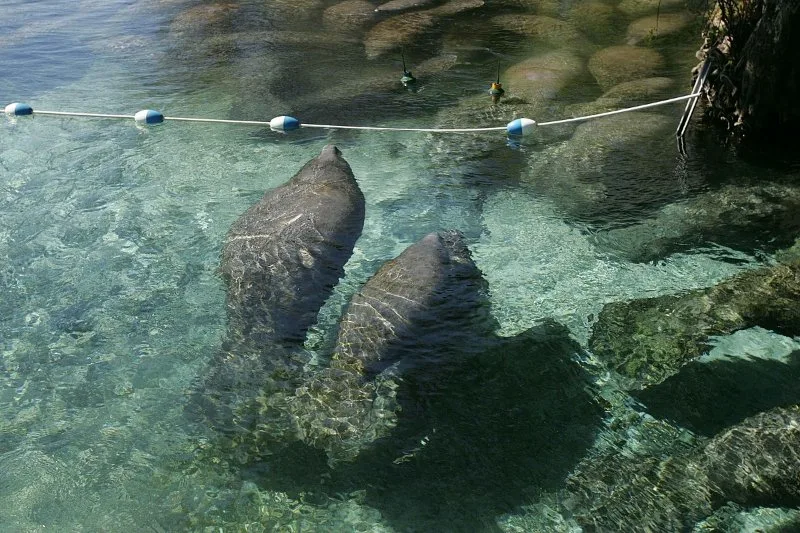
Florida Manatees are a Florida icon, and they’re also surprisingly endangered. They can be found in Florida waterways near shorelines, which is why it’s so common for them to become entangled in fishing gear or killed by boats that don’t follow boat speed restrictions.
Florida Manatee is endangered because Florida has plenty of natural disasters like hurricanes, coastal development, and power plants that pose a threat to manatees.
In recent years, Florida Fish and Wildlife Conservation Commission has been working on ways to protect the species from these dangers.
They’ve been able to help the Florida manatee population rebound with their conservation efforts such as providing resources for better understanding manatee habitats, solving habitat loss, and collaborating with a wildlife research institute that studies migration patterns of this animal.
See Related: Why Were Animals So Big In the Past?
FAQ
What manatees live in Florida?
Florida Manatee is the only manatee that lives in Florida.
This species lives in Florida’s waterways and comes close to shore. These manatee endemic species in Florida are often found on the threatened species list due to these threats, but some conservationists believe that manatee numbers have been increasing over recent years.
What is Florida Manatee?
Florida Manatee is Florida’s state marine mammal. They are large sea cows that can be found in the coastal regions of Florida. It is frequently observed near beaches, making it an easy target for powerboats, fishing gear, and speedboats.
Is the Florida manatee threatened?
The Florida manatee is one of the world’s most endangered marine species due to environmental pollution and habitat loss.
These manatees dwell in the state’s waterways and are known to come within meters of the coast, making them a tempting target for motorboats, fishing gear, and even speedboats.
Are there wild manatees in Florida?
Florida is home to many types of manatees, but they are often found in Florida waterways.
Why Florida Manatee is endangered?
Today Florida Manatee is listed as an endangered species, but they have made a strong recovery since being put on the list of endangered species.
These species are endangered because Florida’s waterways are not safe for these manatee endemic species in Florida to live in.
The manatee endemic species in Florida spend most of their time in freshwater and come near to the coast, making them a target for motorboats, fishing gear, and speedboats. Natural calamities such as hurricanes and coastal development also threaten species.
How can we help Florida manatees?
Florida is one of the places where Florida Manatee can be found in the wild.
Florida also has some organizations dedicated to preserving these manatee endemic species in Florida. It is important that all boaters give these big mammal species extra space. They were threatened by powerboats, fishing gear, and speedboats.
It’s also threatened by natural disasters such as hurricanes and coastal development. The Manatee Florida species is often found on the endangered species list because of these threats, but some conservationists believe these species’ population numbers have increased over recent years.
To help these species supporting conservation like Florida Fish and Wildlife Conservation and Endangered Species Act is among the best options.
Are there still Florida Manatees?
There are still these manatees in the wild even though there are countless threats against them, but they are usually very difficult to find because they’re naturally shy animals that spend most of their time submerged below water.
It’s hard for humans to spot them either, which is why people use sonar that helps detect underwater animals or record boat speed limits around waterways–both methods attempt to protect these species from boat crashes.
Other Species Profiles
Related Resources
